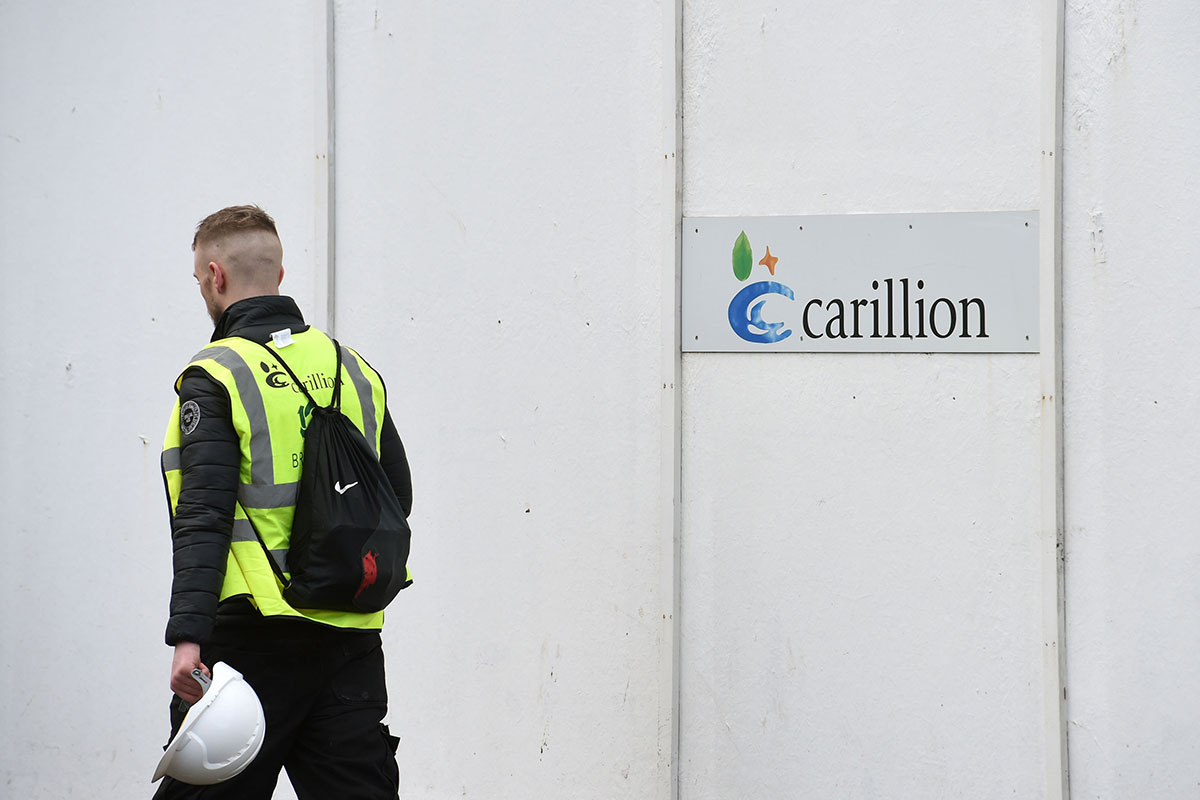You are viewing 1 of your 1 free articles
Social housing contractors in crisis?
Following the collapse of construction giant Carillion and other similar financial failures, should the social housing sector brace itself for more contractor woes? Jack Simpson finds out. Illustration by Jon Heal and photography by Getty/Press Association
“The board of Carillion has concluded it has no choice but to enter into compulsory liquidation with immediate effect,” read the message confirming one of the largest failures in British business history.
Owing an estimated £7bn to its suppliers and leaving a trail of incomplete contracts across the country, Carillion’s collapse sent shockwaves through the construction sector.
Those in social housing were notimmune. More than 12 months on and the impact is still being felt, not only by unpaid suppliers reeling from the lost revenue, but also by Carillion’s contracting rivals, which are dealing with the repercussions of a failure of that size.
“The Carillion effect has created more challenging trading conditions for contractors”
The collapse exposed flaws in construction business models and contractor practices, which has been met by a more concerted effort by public sector clients to fix them.
But the Carillion effect has created more challenging trading conditions for contractors, as shown by recent turbulence at Kier, Mitie and Interserve (which was targeted by short sellers in the aftermath of Carillion’s collapse), and a more vigilant approach from banks and their social housing clients when dealing with contracts.
So with tougher trading conditions and opportunities scarcer, Inside Housing asks if a crisis is building among social housing contractors. And should the sector brace itself for more failures?
The social housing sector has seen a number of high-profile collapses in the past decade, most during the financial crisis. From Kinetics, to Rok, to the biggest of them all, the £660m-turnover contractor Connaught, there is no shortage of casualties to look at.
In many ways these collapses have failed to act as exemplars of what not to do. Contractors’ business models have remained mostly unchanged, and firms still by and large chase volume in terms of the size of contracts and operate on wafer-thin margins.
Noble Francis, economics director at the Construction Products Association (CPA), says contractors have been operating on “slim or negative margins” for at least 15 years and it has taken the Carillion collapse to show that firms can no longer get away with sailing so close to the wind.
To put contractors’ margins into perspective, you just have to look at the last full-year accounts of the sector’s key contractors.
Mears posted a pre-tax profit of £22.2m on revenue of £900.2m for the year ending 31 December 2017 – a pre-tax margin of just 2.4%.
Wates had a pre-tax margin of 2.3%, Mulalley 3.3%, while Engie, which was badly hit by a £72.7m loss in 2017, suffered a negative margin of -10.9%.
“The precarious contracting business model of high risk and low reward is being put under additional pressure by increasingly difficult post-Carillion trading conditions”
By way of comparison, Barratt Developments, Britain’s biggest house builder, had a pre-tax profit of £835.5m and turnover of £4.9bn – an operating margin of 17.7%.
But clients in social housing aren’t blameless; after all, clients make the rules and contractors play the game. A move by many clients to look for lowest-price tenders has driven these behaviours.
The precarious contracting business model of high risk and low reward is being put under additional pressure by increasingly difficult post-Carillion trading conditions.
The payment terms of contractors came under the microscope in the past 12 months, with the government’s public sector clients pushing for 30-day payment terms through procurement – something that goes against how many firms are set up.
In November, the Cabinet Office said it would introduce a prompt payment code which could see late payers banned from public contracts.
As one construction lawyer, who preferred not to be named, explains, contractors have been adopting business models for years that rely on holding on to subcontractors’ money, in some cases for longer than 60 days.
The new, more stringent rules around payment, the lawyer says, will have an enormous impact on firms which are still relying on these models, and will put pressure on their margins. The impact of the stringent payment landscape was evident in Kier’s share rights issue in November.
It said the move was driven by an increase in risk due to more detailed checks on clients’ balance sheets, and an increasing pressure on companies to pay their suppliers more quickly.
The third reason given by the contractor for its problems was the difficulties in obtaining finance.
A lack of confidence in construction has filtered through to the banks, which are more reluctant to lend.
Mr Francis of the CPA says lending to construction was becoming more scarce, with the cost far higher than in previous years.
A lack of confidence in construction has filtered through to the banks, which are more reluctant to lend
In October, Laing O’Rourke, the country’s largest private builder, had to delay filing its accounts due to struggles in securing a refinancing deal. Its chief executive Ray O’Rourke blamed the “historic turbulence” caused by the collapse of contractors, saying this was impacting the approach of banks and insurers to the sector, adding that the lack of finance in the sector is an “issue of critical national importance and concern”.
The increasing uncertainty in banks has spread to housing clients, with many considering more carefully who they contract with, or whether they contract outside of the business at all.
Jon Slade, director at consultancy Campbell Tickell, says there has been a noticeable movement towards in-house delivery of repairs in the past two to three years, as opposed to moving towards big players, which had been a previous safety strategy.
Carillion entered compulsory liquidation in January 2018, a move which its estimated cost the taxpayer £148m
“If you felt in the past that the way of protecting yourself against a collapse was to go with a bigger contractor, Carillion got rid of the notion that bigger was safer,” he says.
Mr Slade adds that uncertainty around Brexit and greater focus on fire safety and regulation post-Grenfell would also likely see contractor prices increase.
The shift is apparent over the past few years with L&Q, Sovereign and Clarion all increasing their in-house delivery. Councils such as Southwark and Kensington and Chelsea have followed suit. The mammoth Northern Ireland Housing Executive (NIHE), the only UK social landlord seriously affected by the Carillion collapse, is also considering the merits of in-house delivery and will publish a report in April.
So with extra pressures on contractors’ business models and a shrinking pool of opportunities for housing associations, there are questions over whether the sector should be bracing itself for more contractor woes.
The sector has already had one high-profile failure in recent times, when in November contractor Forrest - among those to step in to pick up the pieces from the Kinetics collapse – went into administration.
Analysts have said that Kier, which replaced Carillion as the second-biggest construction firm, is in a stronger position. Nonetheless, it has recently been hit by some issues of its own, which culminated in losing its chief executive last week.
“With extra pressures on contractors’ business models and a shrinking pool of opportunities for housing associations, there are questions over whether the sector should be bracing itself for more contractor woes”
Russ Mould, a financial analyst at AJ Bell, says there are similarities between Kier and Carillion, including its debt position, thin margins and wide geographical spread.
Nevertheless, he believes Kier is in a stronger position, doesn’t have a large pension deficit, doesn’t have “fingers in quite as many pies” as Carillion did, and has more cash, having raised £250m from its rights issue.
He also thinks bigger contractors like Kier have the option to sell off assets as a means of raising capital.
In a trading update by Kier last week, it said it was on track to meet its full-year targets, it had reduced its month-end net debt and the future-proofing of the Kier programme was progressing well.
If the past few months are anything to go by, the social housing parts of such a business could be the first to go.
In November we saw Mitie, which has had its own financial troubles in recent times, agree a deal with Mears to offload its social housing arm. Lakehouse sold its property services arm last summer after problems in 2016.
But despite the exit of some contractors, there are still those that see opportunities. Engie snapped up Carillion’s NIHE deals and Forrest’s contract with Anchor Housing Association. Just two years ago it completed the £330m deal for Keepmoat Regeneration. Mears’ £35m acquisition of Mitie’s social housing arm is also an indicator that the company still sees opportunity in the sector.
Nick Sterling, former executive director of Osborne Communities, says there are still many opportunities in the sector for contractors which adapt their model, and that the shift to direct repairs is overstated by some. He estimates only around “10% to 15%” of associations are doing so.
He adds that some which have are now regretting it, and want to go back to market due to the increased efficiencies a large provider can offer.
Regardless, contractors still have an essential role to play. But with a changing market, we are likely to see a smaller number of contractors chasing a smaller pool of work. Some contractors will adapt and thrive. For others, there are challenges ahead. While it is too early to say whether or not the sector will have to deal with another collapse, there is no doubt that the turbulent period hitting the contracting world is not over yet.












